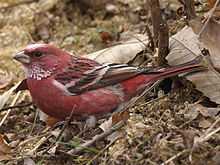Rosefinch
- The rosefinches should not be confused with the rosy finches in the genus Leucosticte.
| Rosefinches | |
|---|---|
 | |
| Pallas's rosefinch (Carpodacus roseus) | |
| Scientific classification | |
| Kingdom: | Animalia |
| Phylum: | Chordata |
| Class: | Aves |
| Order: | Passeriformes |
| Family: | Fringillidae |
| Subfamily: | Carduelinae |
| Genus: | Carpodacus (but see text) Kaup, 1829 |
| Species | |
|
See text. | |
The rosefinches are birds in the finch family Fringillidae. Most Carpodacus species are called "rosefinches". As the names imply, various shades of red are the characteristic plumage colours of this group. The common rosefinch is frequently called the "rosefinch".
Rosefinches are found throughout the northern hemisphere, but the greatest diversity is in Asia. Most species are traditionally placed in the large genus Carpodacus.
Systematics
Comparison of mtDNA cytochrome b sequences strongly indicates that the genus Carpodacus is in need of a thorough revision.[1] For example, the dark-breasted rosefinch, a species with very distinctive appearance, is also very distinct genetically and definitely belongs in another genus, which may even be placed in the chaffinch-brambling subfamily Fringillinae; all other species belong to the cardueline finch subfamily (Carduelinae).
There have been a number of rosefinch radiations. First to split off were the ancestors of the North American species, the common rosefinch, and the scarlet finch, generally placed in its own genus. These groups, which may be related, diverged in the Middle Miocene (about 14–12 mya) from the proto-rosefinches. Each of these groups probably should constitute a distinct genus; in the case of the North American species, this is Haemorhous. The types of the genera Erythrina Brehm 1829 and Carpodacus Kaup 1829 are frequently considered to be the common rosefinch, but both refer to Pallas's rosefinch.[2]
The Long-tailed rosefinch, traditionally also placed in a monotypic genus, is closely allied to the streaked rosefinch and possibly other species; they diverged around 11–10 mya and either might be placed in Carpodacus or united in Uragus. If the latter is adopted, the bulk of the Asian species would be retained in Carpodacus or placed in the genus Rubicilla.
Przewalski's "rosefinch" (Urocynchramus pylzowi) has been determined to be not a rosefinch, and indeed not a true finch at all, but to constitute a monotypic family Urocynchramidae.[3]
A 2011 paper argues on the basis of DNA evidence that the Asian rosefinches are the closest relatives of the Hawaiian honeycreepers.[4]
Species
- Bonin grosbeak (probably a distinct genus Chaunoproctus)
- Bonin grosbeak, Carpodacus ferreorostris
- Dark-breasted rosefinch (probably a distinct genus Procarduelis,[5] perhaps belonging in Fringillinae)
- Dark-breasted rosefinch, Carpodacus nipalensis
- Common rosefinch (probably a distinct genus)
- Common rosefinch, Carpodacus erythrinus
- Streaked rosefinches (possibly genus Uragus and/or Rubicilla)
- Great rosefinch, Carpodacus rubicilla
- Spotted great rosefinch, Carpodacus rubicilla severtzovi
- Streaked rosefinch, Carpodacus rubicilloides
- Long-tailed rosefinch, Carpodacus sibiricus
- Great rosefinch, Carpodacus rubicilla
- Tibetan rosefinch (possibly a distnct genus Kozlowia)
- Tibetan rosefinch, Carpodacus roborowskii
- Red-fronted rosefinch (possibly a distinct genus Pyrrhospiza)
- Red-fronted rosefinch, Carpodacus puniceus
- Asian rosefinches, Carpodacus proper
- Himalayan white-browed rosefinch, Carpodacus thura
- Chinese white-browed rosefinch, Carpodacus dubius
- Pallas's rosefinch, Carpodacus roseus
- Three-banded rosefinch, Carpodacus trifasciatus
- Incertae sedis, placement uncertain (most probably belong to Asian group)
- Blanford's rosefinch, Carpodacus rubescens (perhaps related to dark-breasted rosefinch)
- Himalayan beautiful rosefinch, Carpodacus pulcherrimus
- Chinese beautiful rosefinch, Carpodacus davidianus
- Pink-rumped rosefinch, Carpodacus waltoni
- Pink-browed rosefinch, Carpodacus rhodochroa
- Vinaceous rosefinch, Carpodacus vinaceus
- Taiwan rosefinch, Carpodacus formosanus
- Dark-rumped rosefinch, Carpodacus edwardsii
- Sinai rosefinch, Carpodacus synoicus
- Pale rosefinch, Carpodacus stoliczkae
- Spot-winged rosefinch, Carpodacus rhodopeplus
- Sharpe's rosefinch, Carpodacus verreauxii
- Red-mantled rosefinch, Carpodacus rhodochlamys
- Blyth's rosefinch, Carpodacus grandis
References
- ↑ Arnaiz-Villena, A.; Guillén, J.; Ruiz-del-Valle, V.; Lowy, E.; Zamora, J.; Varela, P.; Stefani, D. & Allende, L. M. (2001). "Phylogeography of crossbills, bullfinches, grosbeaks, and rosefinches". Cellular and Molecular Life Sciences 58 (8): 1159–1166. doi:10.1007/PL00000930. PMID 11529508.
- ↑ Banks, Richard C.; Browning, M. Ralph (July 1995). "Comments on the Status of Revived Old Names for Some North American Birds" (PDF). The Auk (Berkeley, California: University of California Press) 112 (3): 633–648. JSTOR 4088679.
- ↑ Groth, J. G. (2000). "Molecular evidence for the systematic position of Urocynchramus pylzowi" (PDF). Auk 117 (3): 787–792. doi:10.1642/0004-8038(2000)117[0787:MEFTSP]2.0.CO;2. ISSN 0004-8038.
- ↑ Lerner, Heather R. L.; Meyer, Matthias; James, Helen F.; Hofreiter, Michael; Fleischer, Robert C. (2011). "Multilocus Resolution of Phylogeny and Timescale in the Extant Adaptive Radiation of Hawaiian Honeycreepers". Current Biology 21 (21): 1838–1844. doi:10.1016/j.cub.2011.09.039. PMID 22018543.
- ↑ Hodgson, B. H. (1844 (1845)). "Genus: Procarduelis". J. Asiat. Soc. Bengal XIII: 954. Check date values in:
|date=(help)
External links
- Rosefinche videos, photos and sounds on the Internet Bird Collection